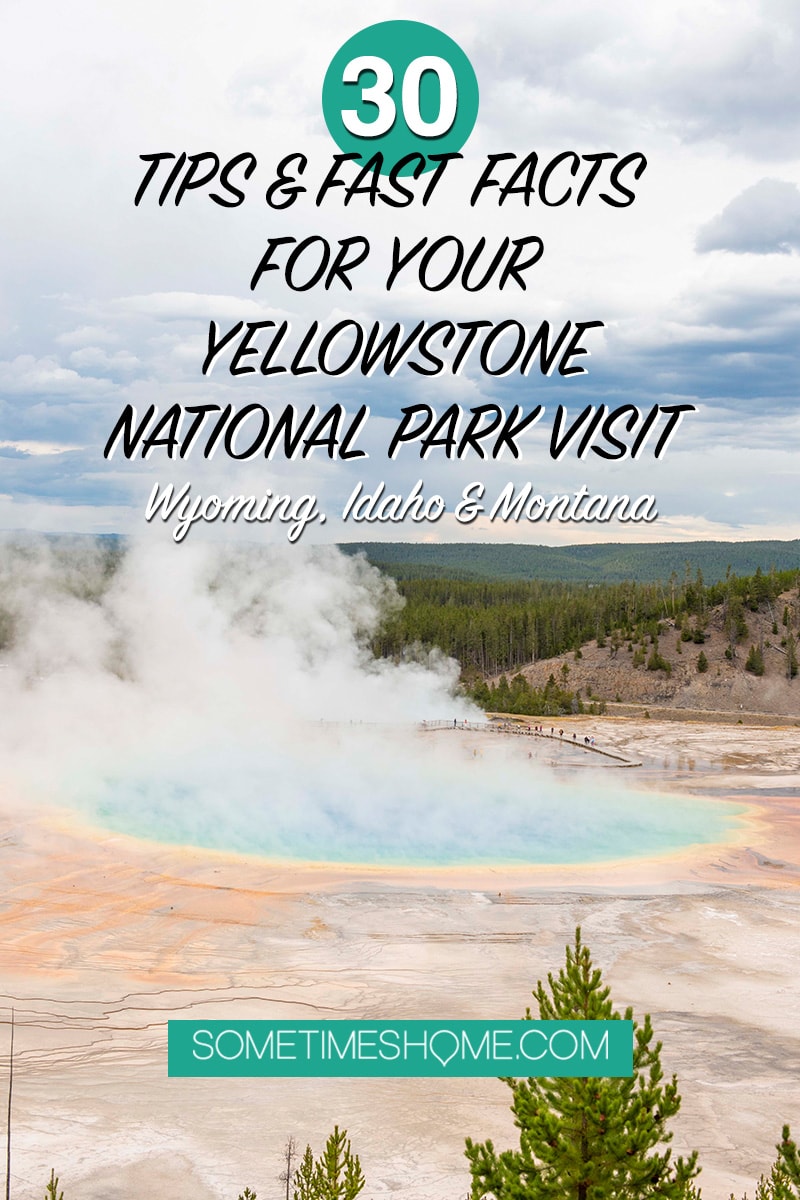30 Facts about Yellowstone and Vital Tips for Your National Park Visit
The nation's first national park will be less intimidating when you visit prepared with our facts about Yellowstone along with helpful tips and information.
Yellowstone National Park is vast, to the tune of 2.2 million acres of land. That makes it bigger than Rhode Island and Delaware, combined!
It can be overwhelming to try and grasp its grandeur, imagining how you'll cover so much ground on your trip there. But fear not – our guide makes it easy for you to navigate this incredible protected land.
Please note: We thank Austin Adventures for generously hosting us. We also may make a small commission from affiliate links in this post but all opinions are ours and we bring you genuine content with real facts, photos, thoughts, and recommendations. Always. As Amazon Associates, we earn from qualifying purchases.
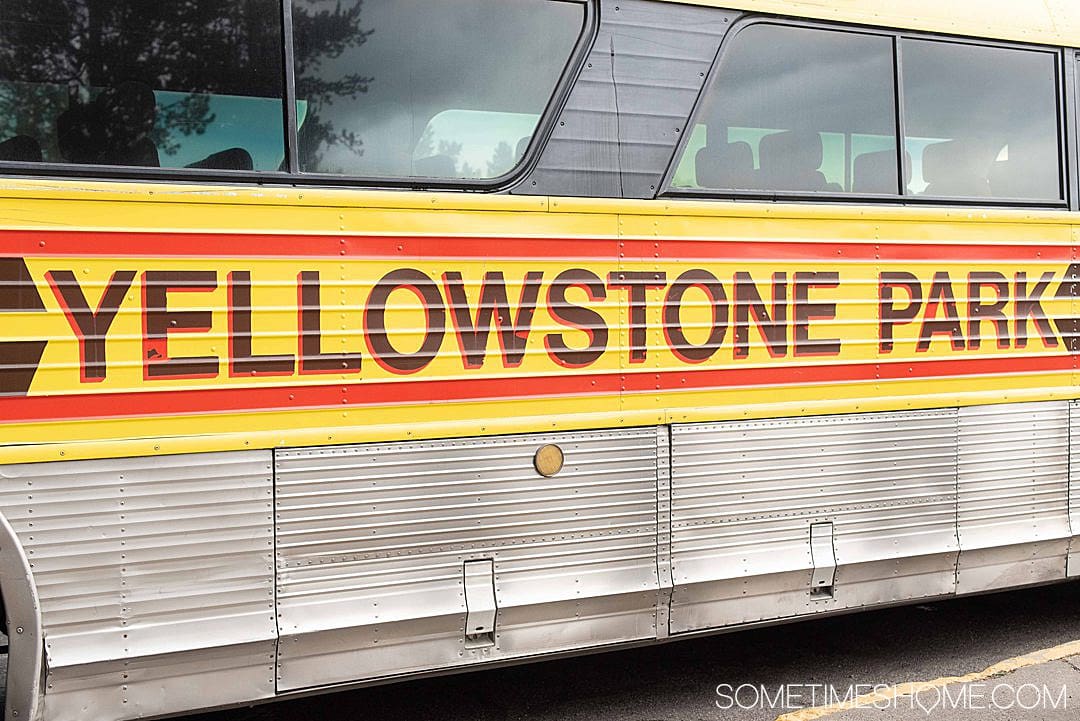
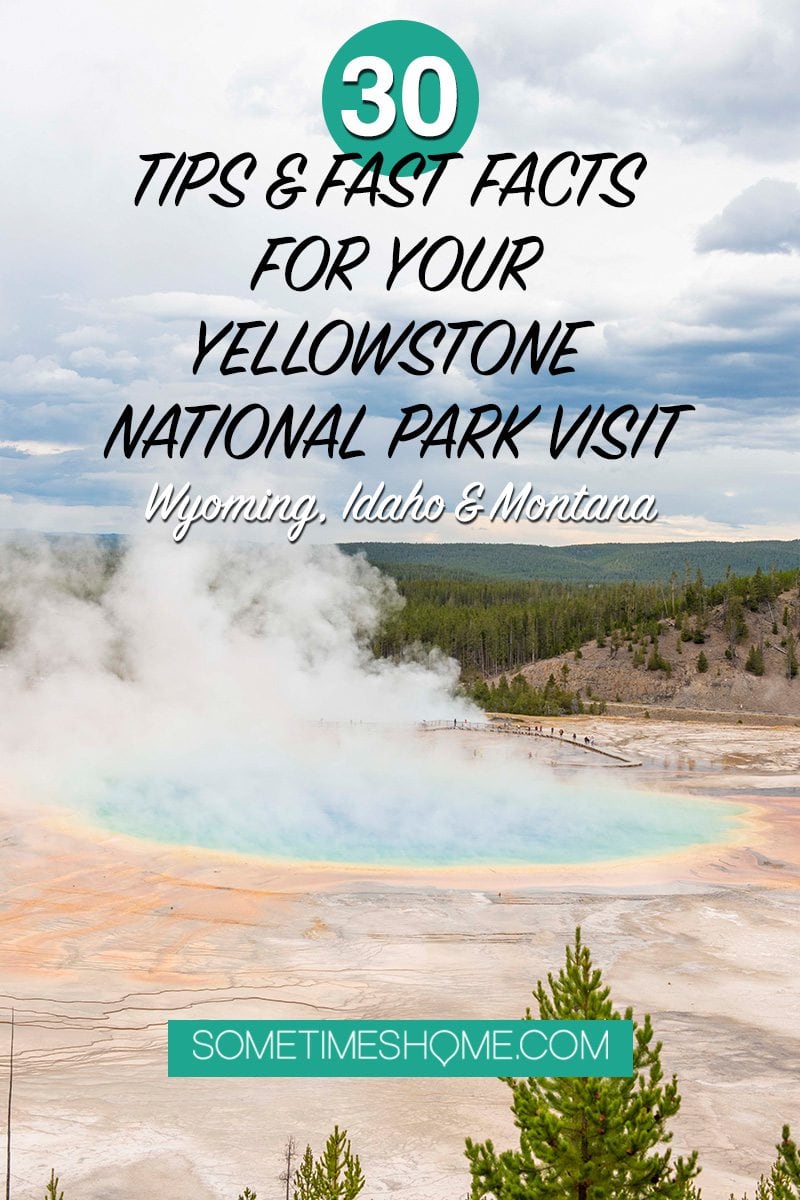
1. You Have to Pay to Get into the Park (Except on a Few Select Days)
There is an entrance fee to get into the park but you should feel good about paying it; 80% of national parks fees go back into the maintenance of the parks.
It is costly to maintain these parks, keep them clean, facilities functioning and improvements going for visitors.
The entrance fee is really a small price to pay for the enjoyment of this magnificent national park and help preserve our beautiful Earth's resources. (We should all do our part to help to save the planet.)
There are typically five free entrance days for the National Parks each year. They usually include:
- Martin Luther King Jr.'s birthday
- First day of National Park week, the second week of April each year
- August 4: Anniversary of the Great American Outdoors Act
- National Public Lands Day, which celebrates the connection between people and green spaces, which is usually around the third week of September (24 or 25, etc).
- November 11: Veterans Day
They may change the dates in future years, so be sure to check Yellowstone National Park's website for updates.
Usual fees are as follows, all good for seven days from the date of purchase:
- $35 for private, non-commercial vehicles, good for seven days (that's the minimum entrance fee)
- $30 for motorcycles
- $20 on foot, bicycle, ski, etc.
If you'll be entering Yellowstone National Park more than twice in one year, you may want to consider a $70 annual pass. Or, even better, is an $80 annual pass to the National Parks overall, which is an incredibly low price if you'll use it a few times in the year across America's National Parks. (Entrance is free for current US Military.)
There are many National Parks nearby you may want to explore that would make the annual pass worth the investment, including:
- Pillar’s National Park, Montana
- Bighorn Canyon, Montana
- Little Bighorn National Battlefield, Montana
- Glacier National Park, Montana
- Grand Teton National Park, Wyoming
2. Yellowstone National Park Spans Three States
Did you know Yellowstone National Park is actually in three states, not one? Here's how much of the park is in these three states:
- Idaho: 1%
- Montana: 3%
- Wyoming: 96%
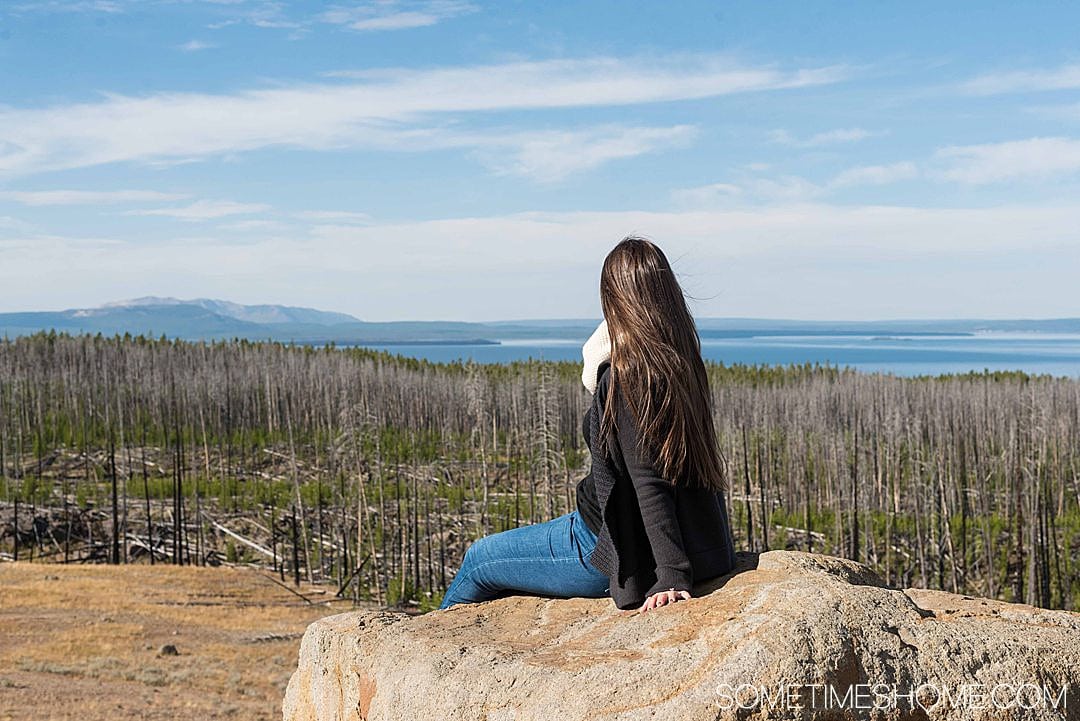
3. How Yellowstone National Park Got Its Name
Yellowstone National Park is named after the Yellowstone River. The river got its name from the Native Americans living in the region, who named it for its colorful yellow rocks.
4. The Nation's First National Park
In 1872 the first national park was born when President Ulysses S. Grant made the Yellowstone National Park Protection Act law. The law protected the park's land from being developed (into housing, for instance) and for any other use but the enjoyment of nature and the land's natural wonders.
Poachers, vandals, and people involved with development in the late 19th century, like woodcutters, still attempted to destroy the area and the animals within its boundaries. Protecting the park wasn't without its battles and perhaps continues today in various ways.
But, overall, Yellowstone National Park has been around for everyone's enjoyment for over a century because of its protection under federal law.
5. There are Five Entrances to the Park
Do you know how Walt Disney World's Animal Kingdom has one entrance to the park? Yellowstone National Park isn't a theme park (we know that) but there's more than one entrance to the park. Which is good because it's huge!
Here are the five entrances to the park, moving clockwise from the north entrance:
- North: closest to Gardiner, Montana
- Northeast: closest to Cooke City-Silver Gate, Beartooth Mountains, and scenic Beartooth Highway, Montana
- East: through Cody, Wyoming (a town I immediately loved!)
- South: through Grand Teton National Park, Wyoming
- West: through West Yellowstone, Idaho
Some of the entrances to the park may be closed depending on the weather (such as after the flooding of Yellowstone and the surrounding areas in late spring 2022) so be sure to check their website for current conditions.
We also highly recommend buying the GyPSy Guide to Yellowstone National Park. It is our FAVORITE self-guided tour app that's worth its weight in gold, never mind the low cost of the app to pretty much give you the most comprehensive tour as you drive through the park yourself.
You simply purchase and download the app while you're on wifi, then it works without wifi or cell service as you drive through the park. It will tell you where to stop, what to skip if you're short on time, and the history of the park.
It's the best and we cannot recommend it enough!
➜ Don't Miss Out on Yellowstone Park Details: Get Your Guide Along Audio Tour!🏔
6. Six Villages Throughout the Park Provide Various Services
Six villages throughout Yellowstone National Park provide important services. Picture them like small cities (or villages, exactly as the name indicates) where you can go for food, car fuel, and even gifts for those back home.
The villages are:
- Canyon Village
- Fishing Bridge
- Grant Village
- Mammoth Hot Springs
- Old Faithful
- Tower Junction
Helpful services, amenities, and shops in the villages include:
- 24-hour gas stations that accept credit cards
- Shopping, including buying gifts, food, and small conveniences like toothpaste
- Accommodations
- Restaurants and cafeterias
- Post offices (except for Tower Junction)
The Yellowstone National Park website is updated with operating hours and times of year for the above.
Even if you forgot something like hiking shoes, fishing tackles, or a sleeping bag, the store at Canyon Village is available for you to pick some up!
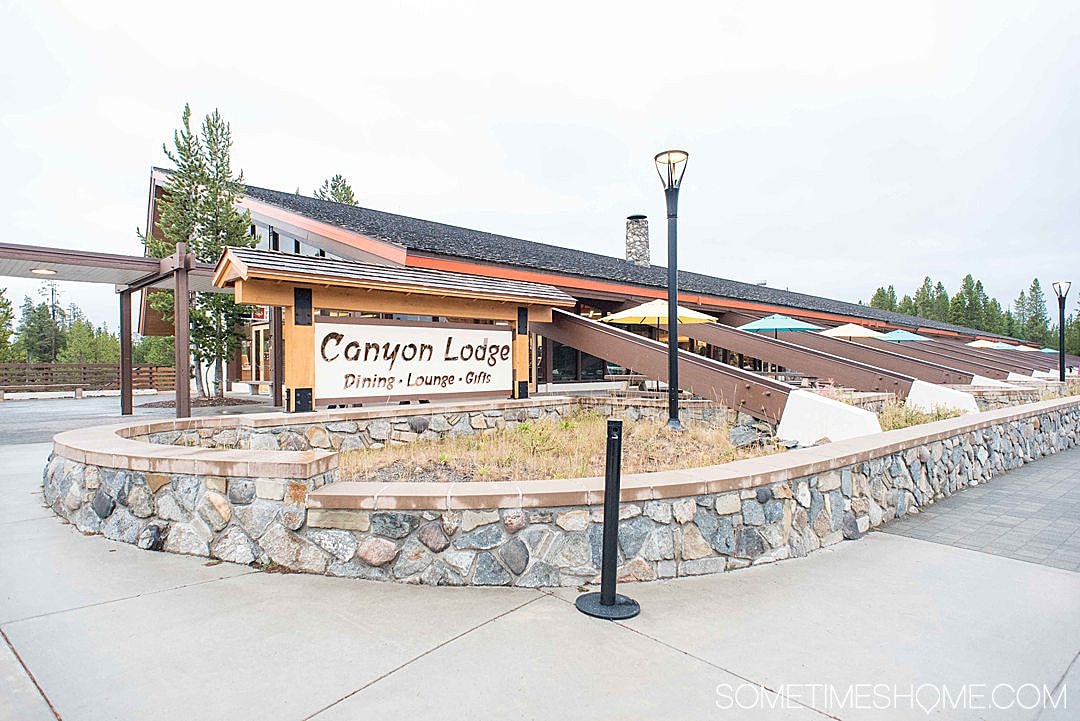
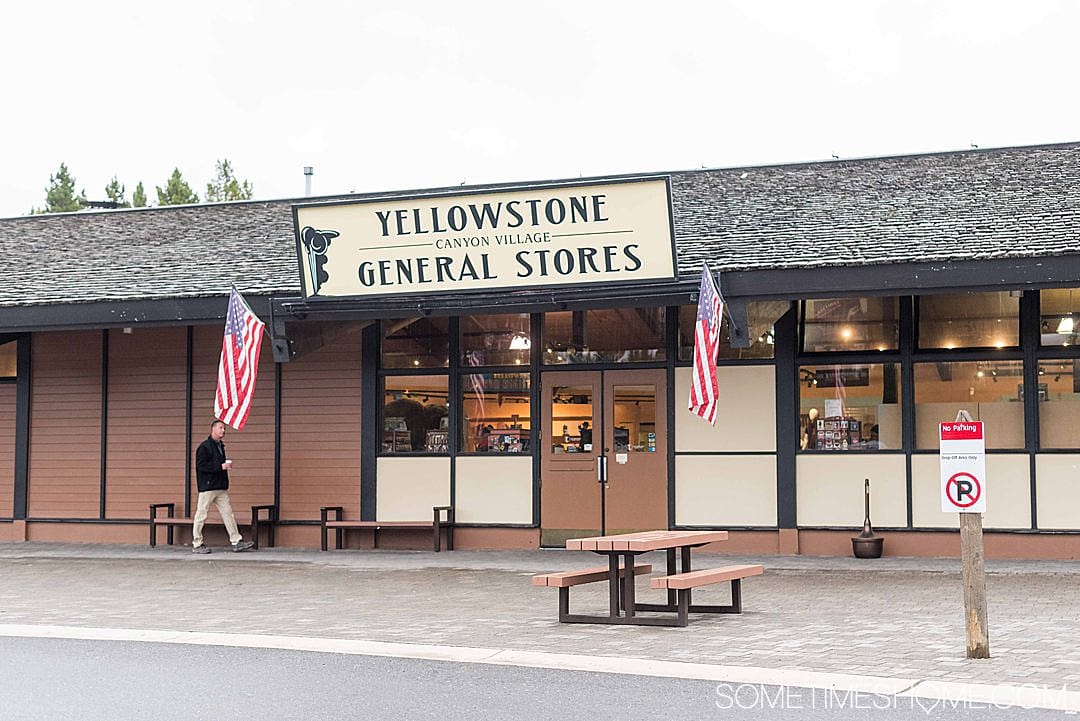
7. You're Able to Stay in Yellowstone National Park Overnight
There are several ways to stay in Yellowstone National Park overnight. Here are the options:
- Lodges
- Cabins
- Camping (RVs, tents, etc.)
Lodges are the types of hotels Dan and I are used to staying in. Cabins are a little bit of an in-between for lodges and camping. They're pretty rustic but if you're not into the idea of pitching your own tent or have an RV, or feel better in a cabin with sturdy walls with bears around, it's a good option.
The lodges aren't open all year. Overall, they're seasonal and only some are open throughout November and during winter. Yellowstone National Park has its own dedicated website where you can reserve rooms and find out extensive information about which best fits your needs.
Lodges book up fast, especially during peak times, and many dates sell out months in advance.
Note: Park entrance fees are not included in any reservations.
We stayed at Canyon Lodge (the Moran Lodge building, to be exact) which was remodeled just a couple of years ago, and it was quite nice! I was delighted to find several recycling options in my room and the absence of televisions. (And there was not wifi in the room.)
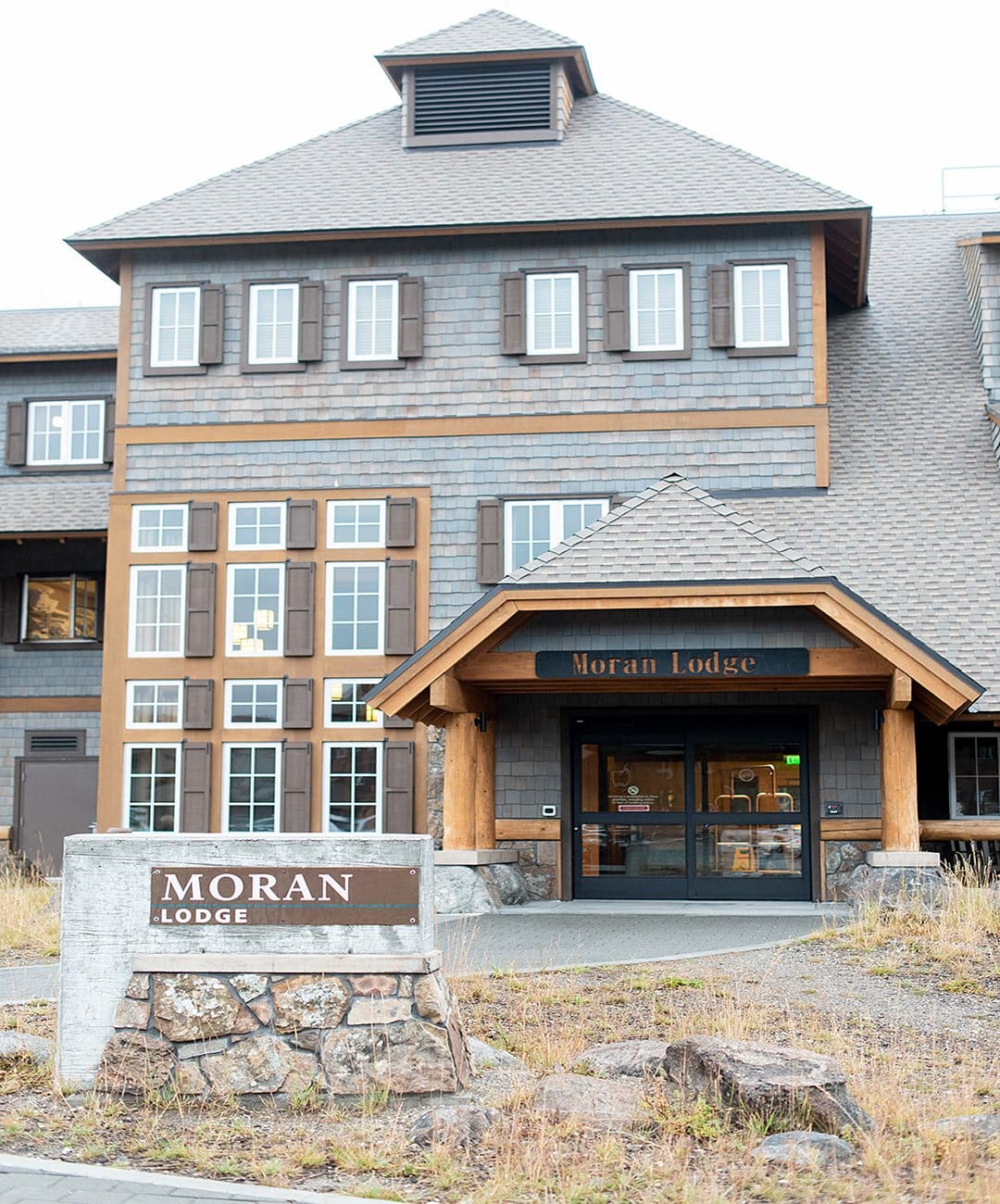
8. You Can Easily Stay Right Outside the Park Entrances Too
Several towns surrounding the park entrances to Yellowstone National Parks largely thrive on park visitors staying in their cities, just outside the park's entrances.
Two examples we stayed in on my Austin Adventures trip were:
- Cody, Wyoming, outside the East entrance to the park
- Cooke City, Wyoming, outside the Northeast entrance to the park
In both cities, we were able to easily move in and out of the park with the receipt from the entrance ticket that was purchased at our original entry point. (It's a good idea to simply tape the receipt onto your windshield if it won't obstruct your view, so you always know where it is.)
It was fun to stay both within the park boundaries and outside, to see more surrounding areas, and try more restaurants. I loved that Austin Adventures took care of all of it too – we didn't have to find or book the hotels yet they were all wonderful!
9. You Can Have a Casual or Nice Meal in Yellowstone
I briefly touched on restaurants and cafeterias being available in the park. It's worth elaborating on that mention because I was so blown away by the abundance of dining options. They also do their best to support local, sourcing 50% of the food and ingredients in the parks from local resources.
You can do a casual lunch as we did at the deli at Old Faithful. We got sandwiches, drinks, and side salads to go and headed up to the outdoor balcony that overlooks the geyser. It was prime seating as we awaited its next eruption.
Later on, we ate dinner at Canyon Lodge Eatery, which was a cafeteria-style dining option. We all grabbed trays and went through lines for our orders, paid a cashier, self-filled drink cups and sat at long tables to eat.
There are also more formal options where you can sit down and have waitstaff serve you. Some restaurants are open for lunch and dinner and others just for dinner. The Great Village Dining Room, open May through September, has a casual dress code but offers prime rib, shrimp, and bison meatloaf as options.
Reservations are required for dinner, as is the case for many sit-down restaurants in Yellowstone National Park.
10. There Are a Lot of Water Fill Stations throughout Yellowstone National Park
There were many water-filling stations for reusable bottles throughout the park. Each of the five villages in the park has several scattered throughout the lodges, restaurants, general stores, and such.
You’ll want to drink plenty of water, too, due to the higher elevations in the park. I’m used to low elevation numbers, like 315 feet above sea level in Raleigh and 200 feet on Long Island. But in Yellowstone, we’re talking well over 9,000 feet above sea level, even upwards of 11,000 feet in some areas.
Higher elevations can do weird things to your breathing and head, and though I didn’t personally feel any notable effects I was sure to drink water! (And perhaps that's why I was a-okay. So drink water and bring a refillable water bottle.)
Don't forget to bring your refillable water bottle. We love two that we regularly travel with:
- Memo bottle: We love it because it's flat, so it fits in a pocket, on the side of a backpack, in a purse, etc. very easily and comfortably.
- MiiR bottles: They're insulated and keep the liquid at the temperature you added it to the bottle in for HOURS and hours. They rock. We also love that the wide-mouthed bottles are easy to get ice cubes into. Use code “SOMETIMESHOME” for 15% off your order.
➜ Buy a MiiR Water Bottle (they give back to great causes, too!) 💦
The Best Refillable Travel Water Bottles
Memo Bottle
We love these because they're flat, so it fits in a pocket, on the side of a backpack, in a purse, etc. very easily and comfortably.
MiiR Bottle
They’re insulated and keep the liquid at the temperature you added it to the bottle in for HOURS and hours. They rock.
We also love that the wide-mouthed bottles are easy to get ice cubes into. Use code “SOMETIMESHOME” for 15% off your order.
Collapsible Water Bottle
This Nomader water bottle saves a lot of space when rolled up before filling. The only reason we don't carry one is because we're worried about squishing it when it's filled with water. But it's a great option if it fits your needs.
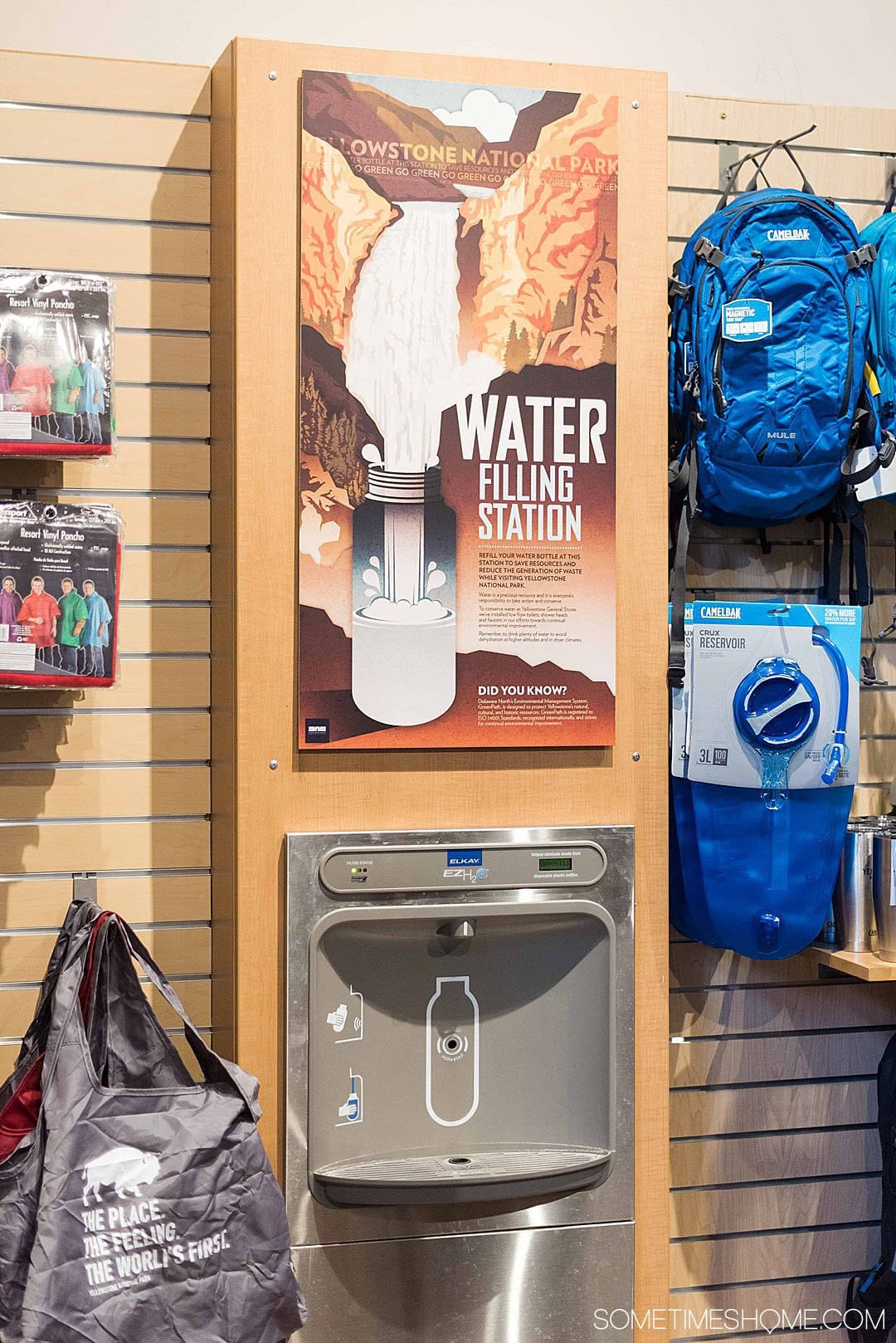
11. Visitors Centers are Interesting and Worth a Stop
There are six Visitor Centers in the park. They're laid out in a circle of sorts within the park so you're never far from one. And they all have exhibits from what I understand. The Canyon Lodge Village had a particularly interesting scale model of the topography of Yellowstone National Park I enjoyed.
It's also a great idea to stop in, use the restrooms if needed, fill your refillable water bottle and ask a ranger on duty any pressing questions you may have, like info about road closures.
And if you're at all interested in this history of National Park Rangers, who are largely accountable for keeping the parks safe and running smoothly, there's a Museum of the National Park Ranger inside Yellowstone too.
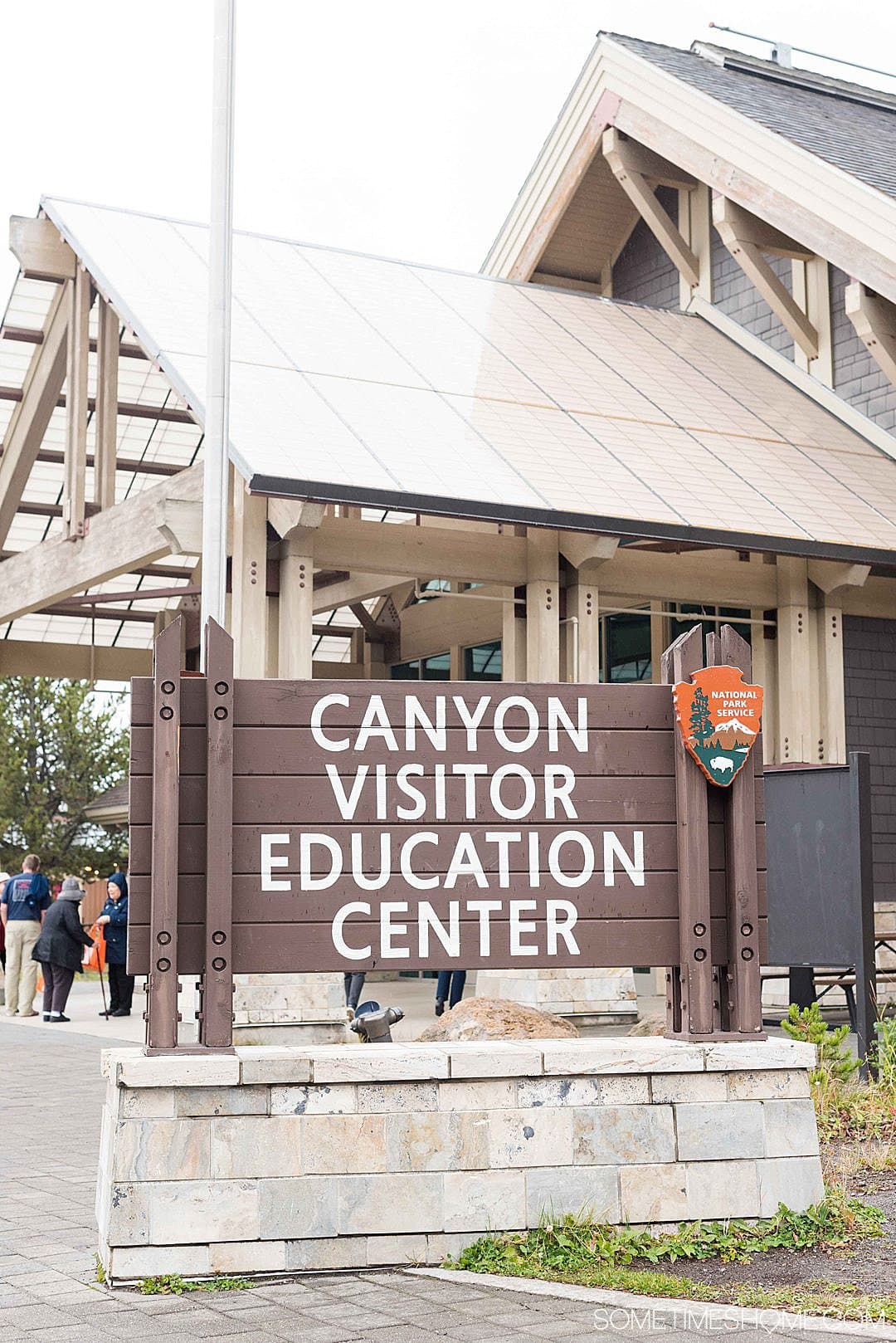
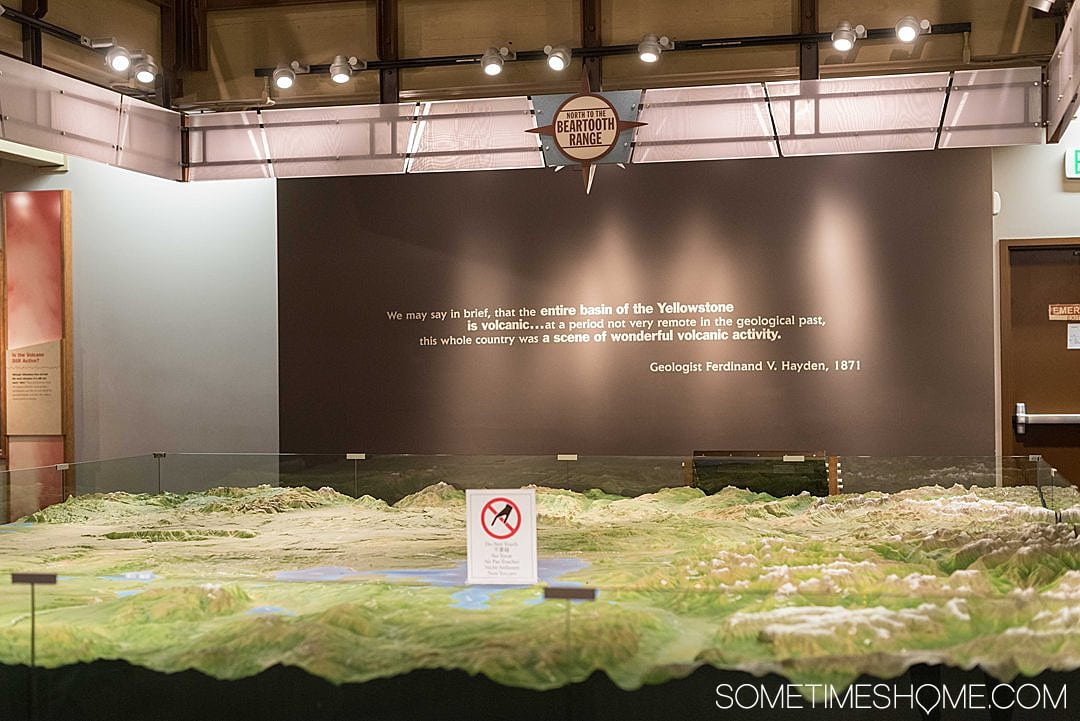
12. There are More Bathrooms than Expected at Yellowstone National Park
I’m constantly wondering, “Where is there going to be a bathroom?” on trips. I truly get bathroom anxiety. I was pleasantly surprised at the abundance of bathrooms in Yellowstone. (Technically they are latrines, which are basically holes that reach deep in the ground that don't require a “flush” as your home toilet does.)
They're kept clean and stocked with toilet paper. Just bring some anti-bacterial gel with you in case there isn't an area to wash your hands.
They're not luxurious but I have to say I was impressed and pleasantly surprised by them. And, best of all, they were frequent and easy to find!
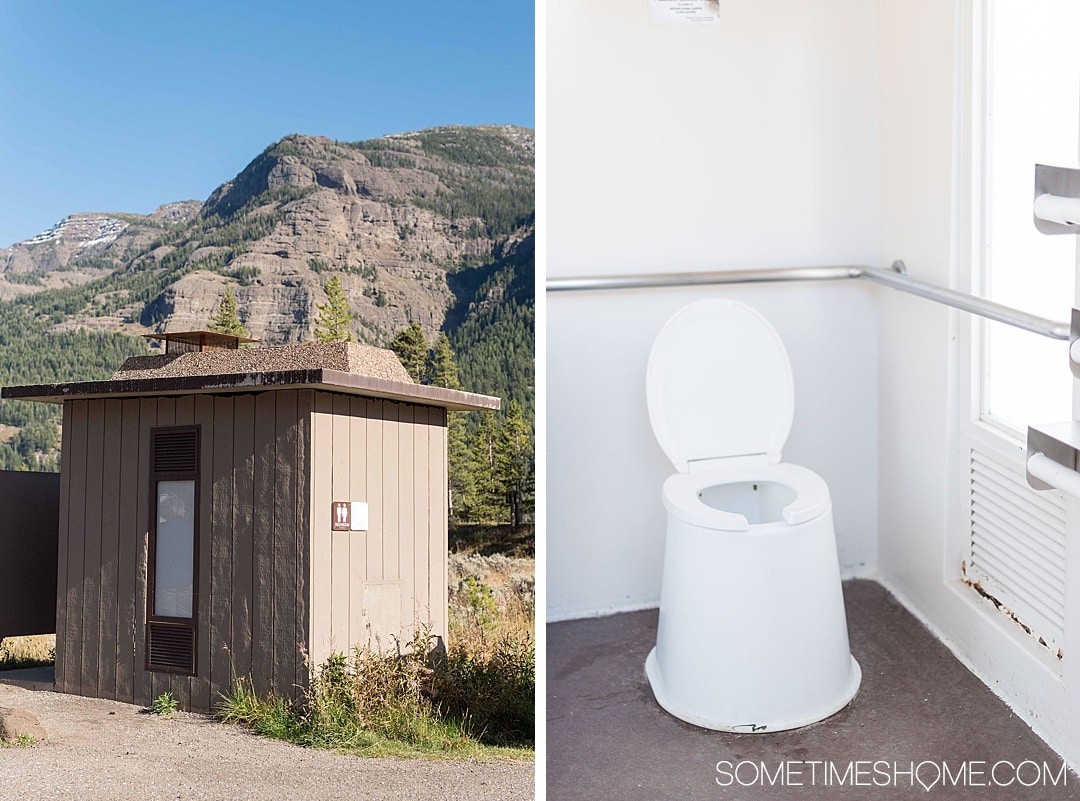
13. It's Incredibly Easy to Find and Buy Alcohol in Yellowstone National Park
Perhaps it’s the risk of intoxication while hiking or the bears you could get mixed up with on the trails (rare but definitely possible) that lessened my expectation of alcohol availability. So imagine my surprise when I discovered there is no shortage of alcohol in Yellowstone National Park!
I couldn’t believe the shelves of both hard liquors and beer and wine in the shops at each village we went to. And there are bars at hotels and restaurants there too! If you’re looking to have a cocktail before bed and you’re staying in the park, or a drink with lunch, it’s entirely possible. And options are abundant. (Who'd have thunk it?)
Just one of our Yellowstone tips and facts for you if you like to unwind with a drink after a day of exploration.
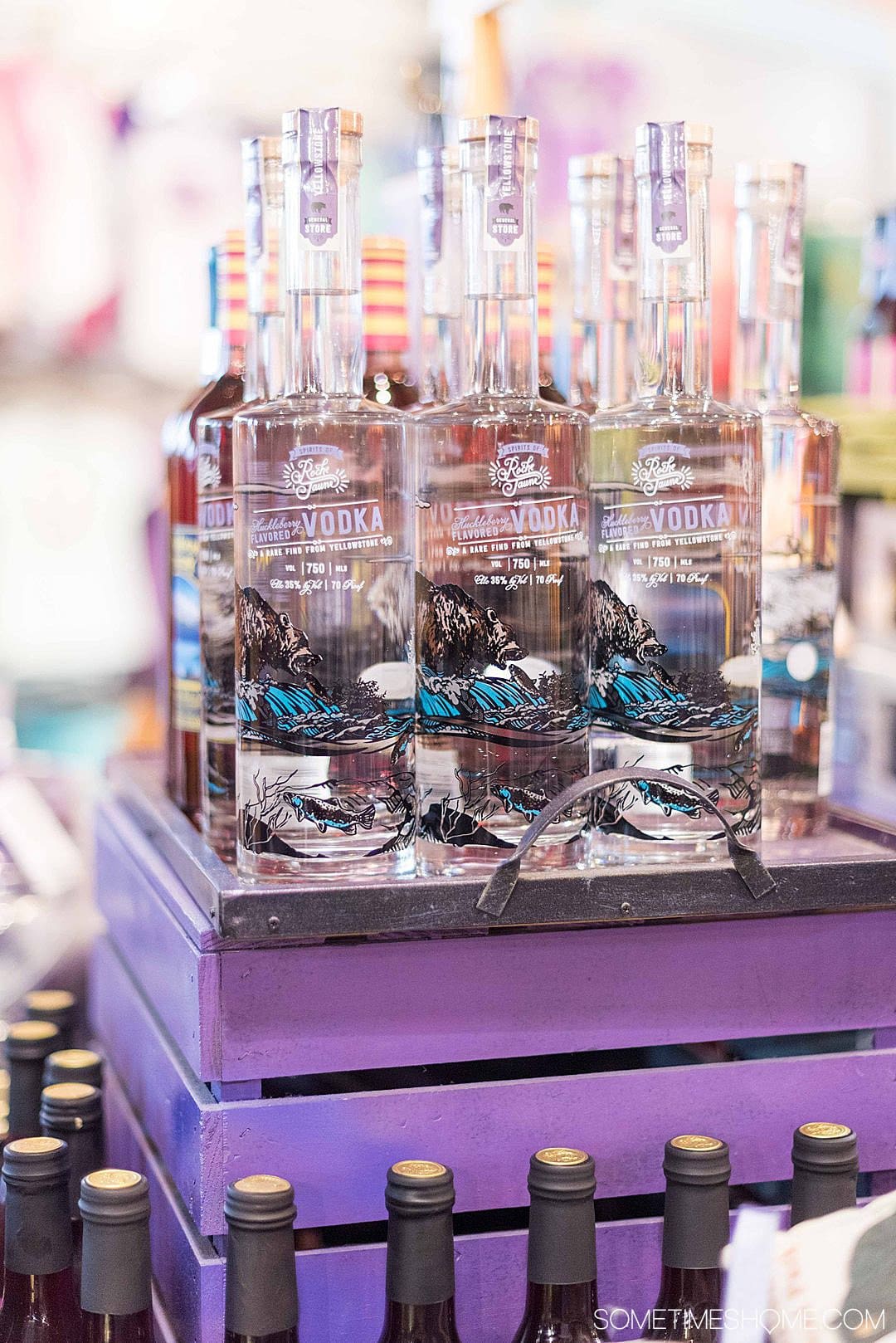
14. Hitchhiking is Acceptable in Yellowstone
Hitchhiking within the park is legal and acceptable with a few rules. For instance, you can't hitchhike and wear dark-colored clothes at night. And you cannot hold a sign larger than two feet, square. You also cannot hitchhike while intoxicated.
We saw a hitchhiker on the side of the road and park police drove right by him without stopping to say anything to ticket him. That's because he was safely hitchhiking according to the rules and laws of the park, with a thumb up on the side of the road during the day, not by any government building or entrances to the park. Hitchhike – or pick up hitchhikers – at your own will and risk.
15. People are Nice
I’m sure there are exceptions to this rule but, generally speaking, everyone we encountered in Yellowstone National Park was really friendly. You’re essentially all there for similar reasons, most of which likely include appreciating and enjoying nature, including spotting wildlife.
If you see some people pulled over on the side of the road simply ask what they are looking at. They’ll share immediately. Or if you are all trying to spot the same pack of wolves, as we were one morning after sunrise, and you don’t have as strong a scope as your neighbors, simply ask if you can view from their lens.
It was a great feeling to want to share the joy of seeing wolves in the wild and share the news of a bear walking by the road.
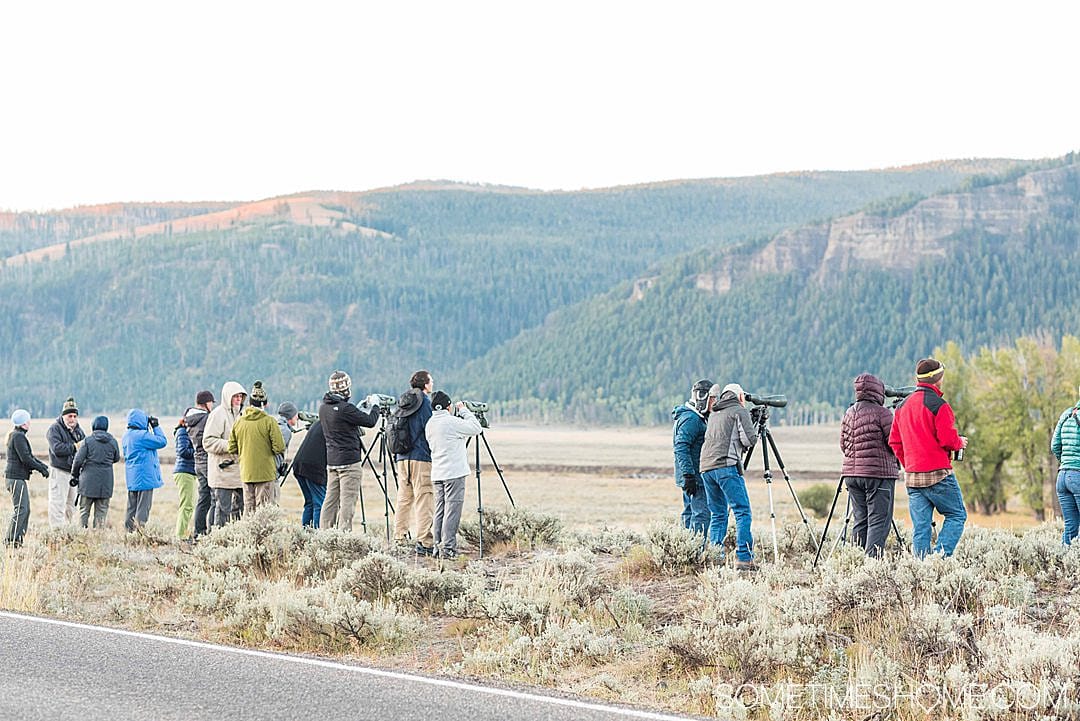
At one point we saw so many cars pulled over on the side of the road on a sunny day we couldn't resist stopping too. We asked what everyone was looking at and someone was quick to point out a cinnamon Black Bear nearby. (Can you spot it in the picture with the trees below?) So share the love and the kindness!
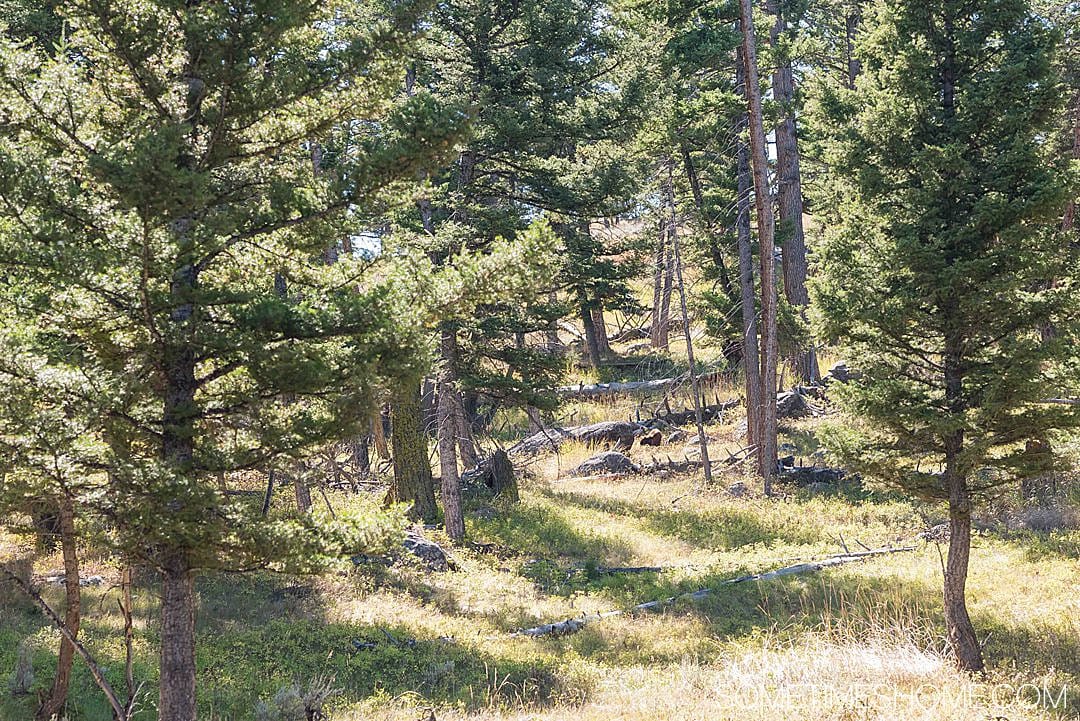
16. You Can Rent a Scope
I’m an avid, professional photographer. But I’m not a usual wildlife seeker. As such, with my wildlife-seeking inexperience, the thought to rent a scope didn’t cross my mind until I was talking to a man who was exploring Yellowstone solo.
(While the thought to rent a lens for my camera, if need be, would cross my mind.) He shared he rented his scope for $25 per day in Gardiner, a city right outside Yellowstone National Park, at a store called Yellowstone Forever. There's also a General Store you can rent a scope from in Silver Gate.
What a great idea. Because why buy a scope, that is likely thousands of dollars and the average person won’t use much when you can rent one?
That’s why these rental options exist. We had a scope available for our use with our Austin Adventures trip, but I’ll admit the scope our “neighbors” had during our wolf pack watching was much stronger than ours. All in all though, better to have a scope than not have one at all.
A scope is sometimes better than binoculars because you can set it up on a tripod and focus it, and it often sees further than some binoculars can.
Below is the view from our scope on the left. You see dots in the distance, which are the wolves we were trying to see. The right image is one I took on the scope our “neighbors” generously let us look through. You can see the wolves much more clearly! That's the scope the image below is from as well.
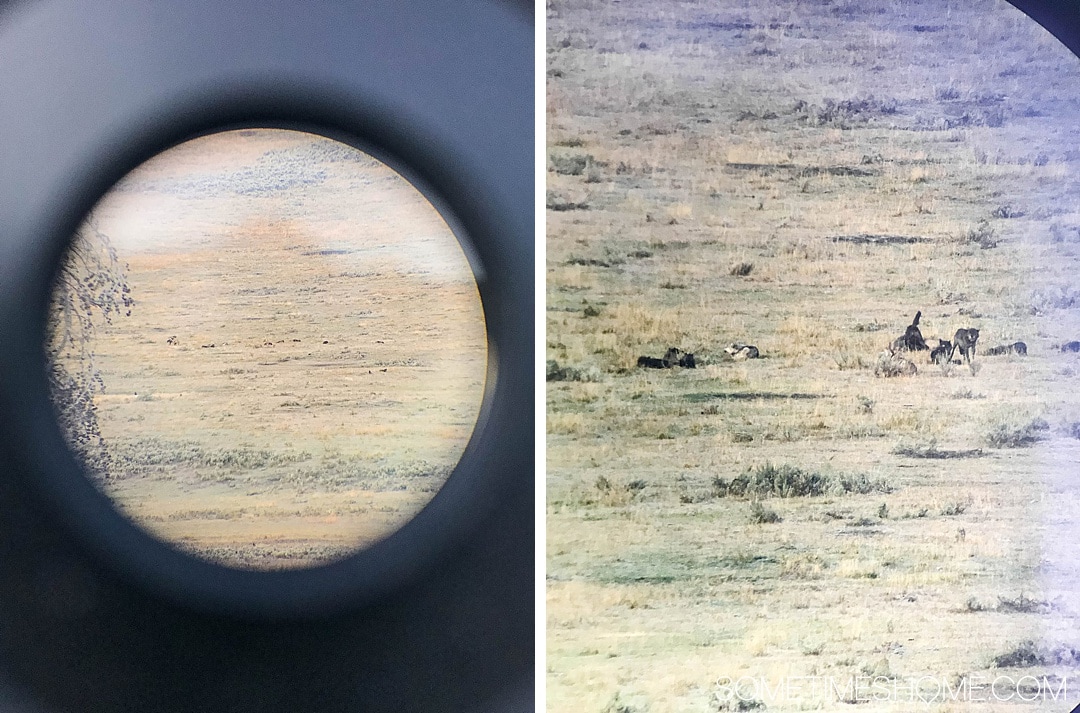
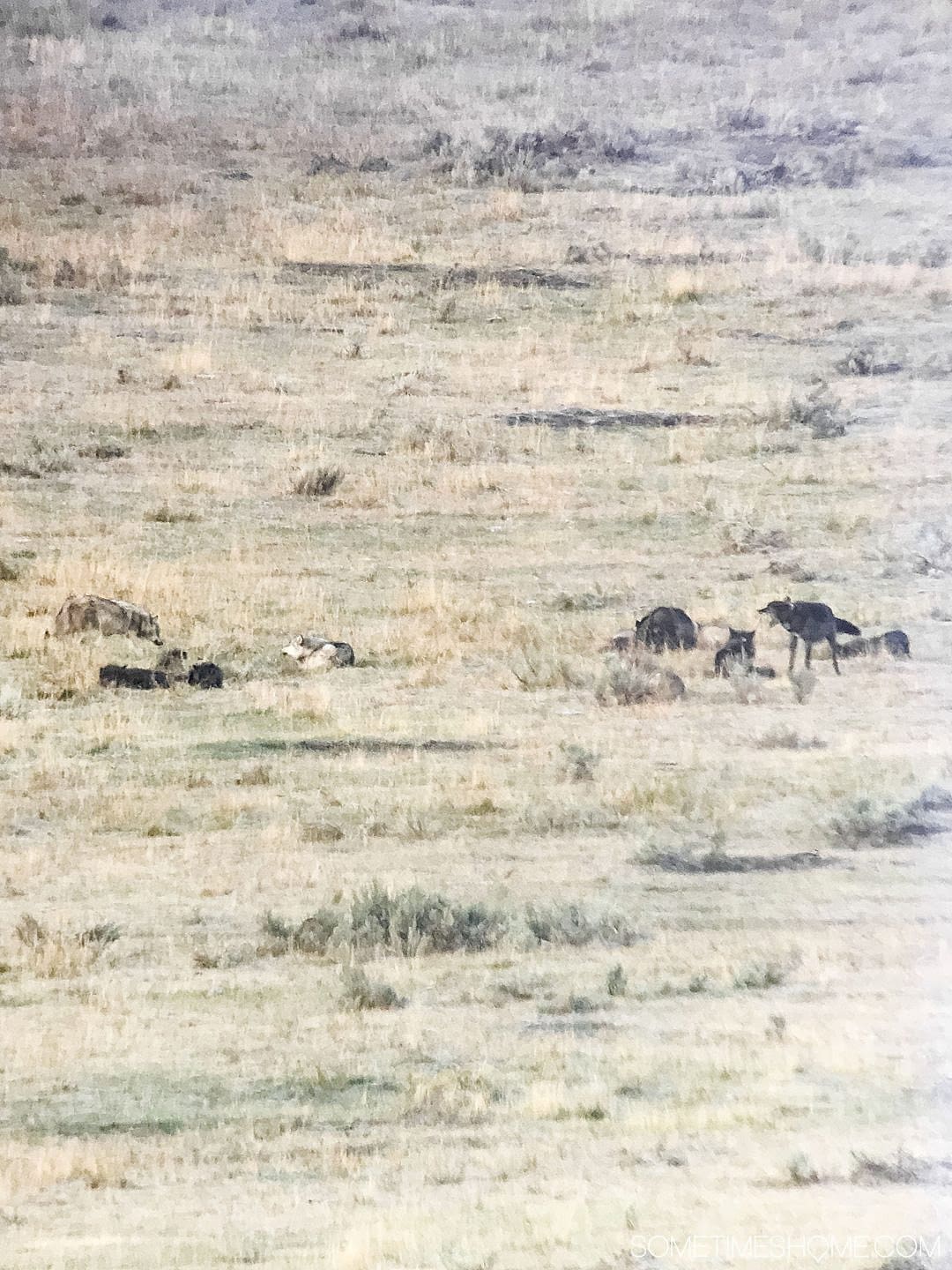
17. Microclimates are Real and Sometimes Intense in Yellowstone National Park
I heard there were microclimates in Yellowstone and expected it. But what I didn’t quite expect was how extreme they can be. It can go from sunny and 60 degrees to 32 degrees and snowy within minutes as you drive through the park and quickly change altitudes.
We drove from one area in jeans and long sleeve shirts to another area with snow falling on the mountain. We needed to add layers to keep warm! I walked out of our Austin Adventures van with a winter coat, scarf, and another layer of pants. (We were there mid-September but it's my understanding this is quite common during peak visitor times from May to September.)
The key tip and takeaway are: bring many options for layering your clothes, including winter coats, hats, gloves, and scarves. You just never know in Yellowstone National Park! Which is sort of a cool part of the journey and experience…as long as you're prepared.
All of the photos in this post are from one trip so whether I'm in a t-shirt or winter coat and scarf, it was within either the same three-day span or several hours.
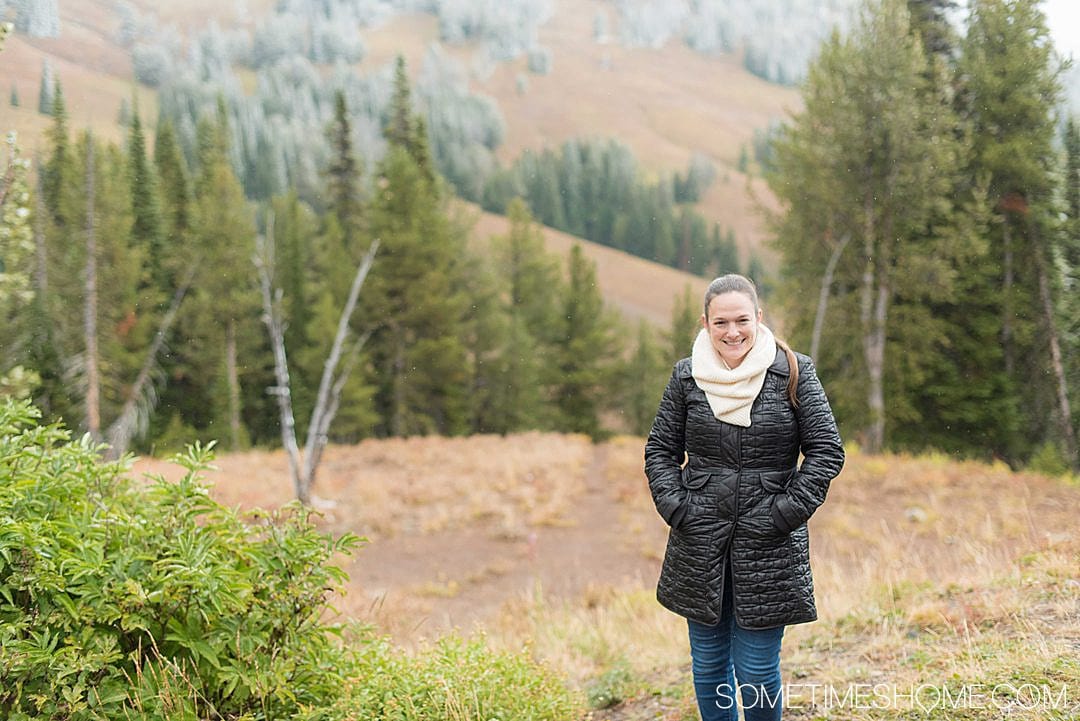
18. Look Forward to Many “Pull Over!” Experiences on the Roads and Scenic Overlooks
There are a good amount of scenic overlooks and parking areas in Yellowstone National Park for visitors to stop and enjoy the view. Or stop to try to find wildlife, even goats on a mountain in the distance, for example. Or pull over and get out of the vehicle safely to pose for a photo with an iconic sign like “Continental Divide”.
Even if there isn’t technically a place to pull over you’ll see plenty of cars on the sides of the road where there’s a shoulder. Why wait for an overlook when it could mean missing a black bear walking through boulders? Or an American Buffalo just off the side of the road?
Remember to keep safety for yourself and the animal(s) your number one priority!
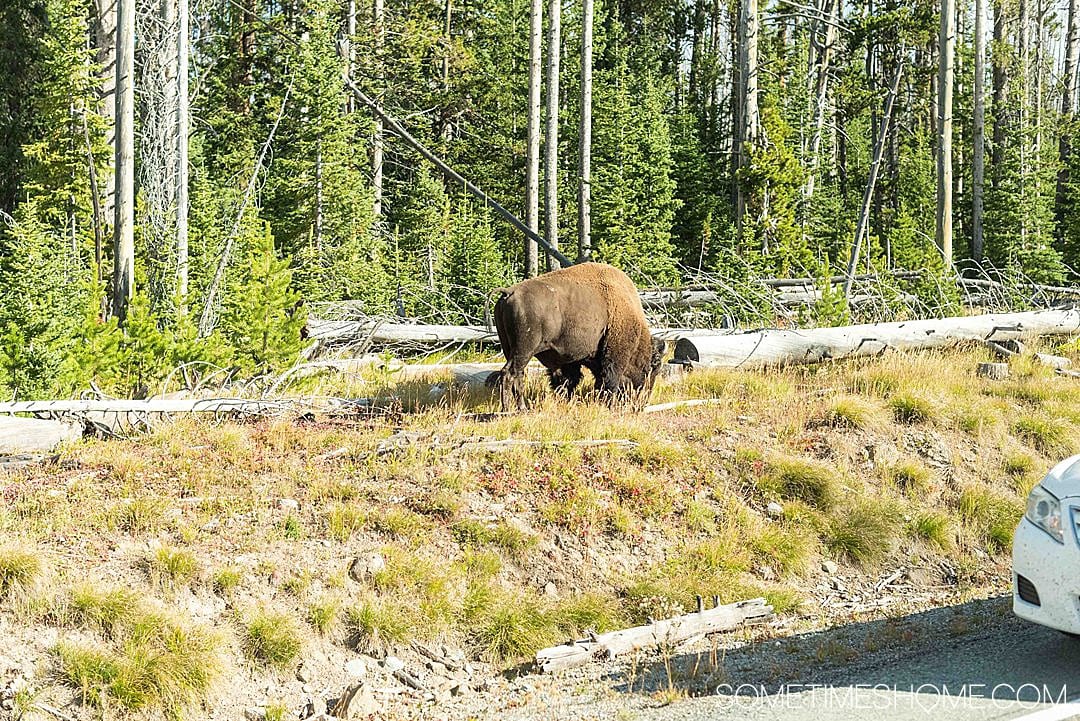
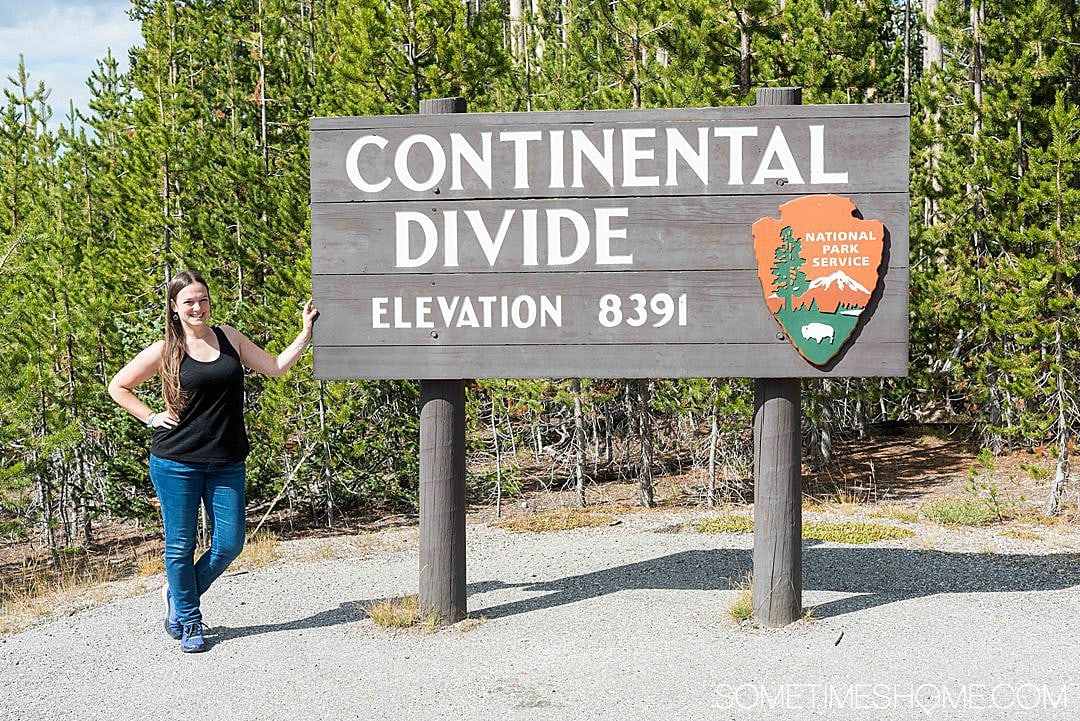
19. There is No Cell Service in Most of the Park
In this day and age, it’s hard to believe there are areas with limited to no cell service. Let’s face it: we’re a nation addicted to our phones. Yet believe, it is because there is almost no cell service (and hardly any wifi) in Yellowstone National Park!
Their website says there is cell service in 50% of the park, depending on your carrier but we couldn't have found that farther from the truth. We'd say it was more like 2% of the time there was poor cell service.
We weren't even there during peak times, like June and July, when the increased population of visitors in the park makes cell service even less likely.
It’s best to give in to the notion of being offline and alert family and friends ahead of time in case they try to reach you. Accept that you’ll be off the grid, like the good ‘ole days – while you’re in the park.
It’s a bit of a nuisance if you need to answer emails and do a little business while there (as a small business owner that’s simply the reality of my day-to-day, no matter where I am, vacation or not). But you’ll need to plan ahead, turn on an “out of office” message and face the facts about this.
Verizon is my cell service carrier and I had a little service once in a blue moon but nothing reliable or regular. It was totally unpredictable and very limited.
20. Don't Rely on Wifi
You shouldn't expect to rely on wifi as it's also incredibly limited.
Albright Visitor Center in Mammoth Hot Springs has free wifi and there's also some available internet at the hotels and lodges throughout the park if you're a guest staying overnight.
21. What to do in the Case of an Emergency at Yellowstone National Park
The lack of cell service begs the question, “How would you call for help in case of an emergency?” There are emergency call boxes throughout the park in case you need them.
This would be necessary if you were bitten by wildlife, or somehow burned by a geyser, twisted an ankle while hiking, and could limp until you found an energy call box or a friend with whom you could seek one out, etc.
We know: this is unlikely to occur then perhaps unlikely you'll be able to find a call box if injured. But since we asked the question when we were riding around with Austin Adventures I thought it was worth mentioning.
They also have medical services in the park. Mammoth Clinic is open year-round and other clinics, including Lake and Old Faithful Clinics, are open during summer. As always, in case of an emergency, whether you think you have cell service or not, dial 911.
22. The Yellowstone National Park App Can be Helpful and Informative
I know what you are thinking – there's an app but no cell service? Luckily you can set the app to download content for use offline.
You can do this in one of two ways:
- Open the app after downloading and scroll through its initialization prompts. When it mentions “Use Offline,” click “Download Now”
- Download offline content in the NPS National Park app in your phone settings after downloading the app
You won't be able to get real-time updates, like geyser eruption times, when you're offline but you will be above to have access to maps, for example. They even have self-guided audio tours on the app, which I think always enhances an experience.
If you go into settings within the app, you're able to turn on tour audio as well so you'll get automatic tour info as you move throughout the park according to the GPS coordinates where you are.
Another cool thing about the app is you can browse things to do and see and bookmark the ones you want to remember. Then go back to those bookmarks for reference, even when you're in the park without cell service.
Extensive information about attractions is also available in the app, like the geology of Artist Point and what the organisms at Grand Prismatic mean for its color. Just click “Read More” when reading the opening sentences about a location in the app.
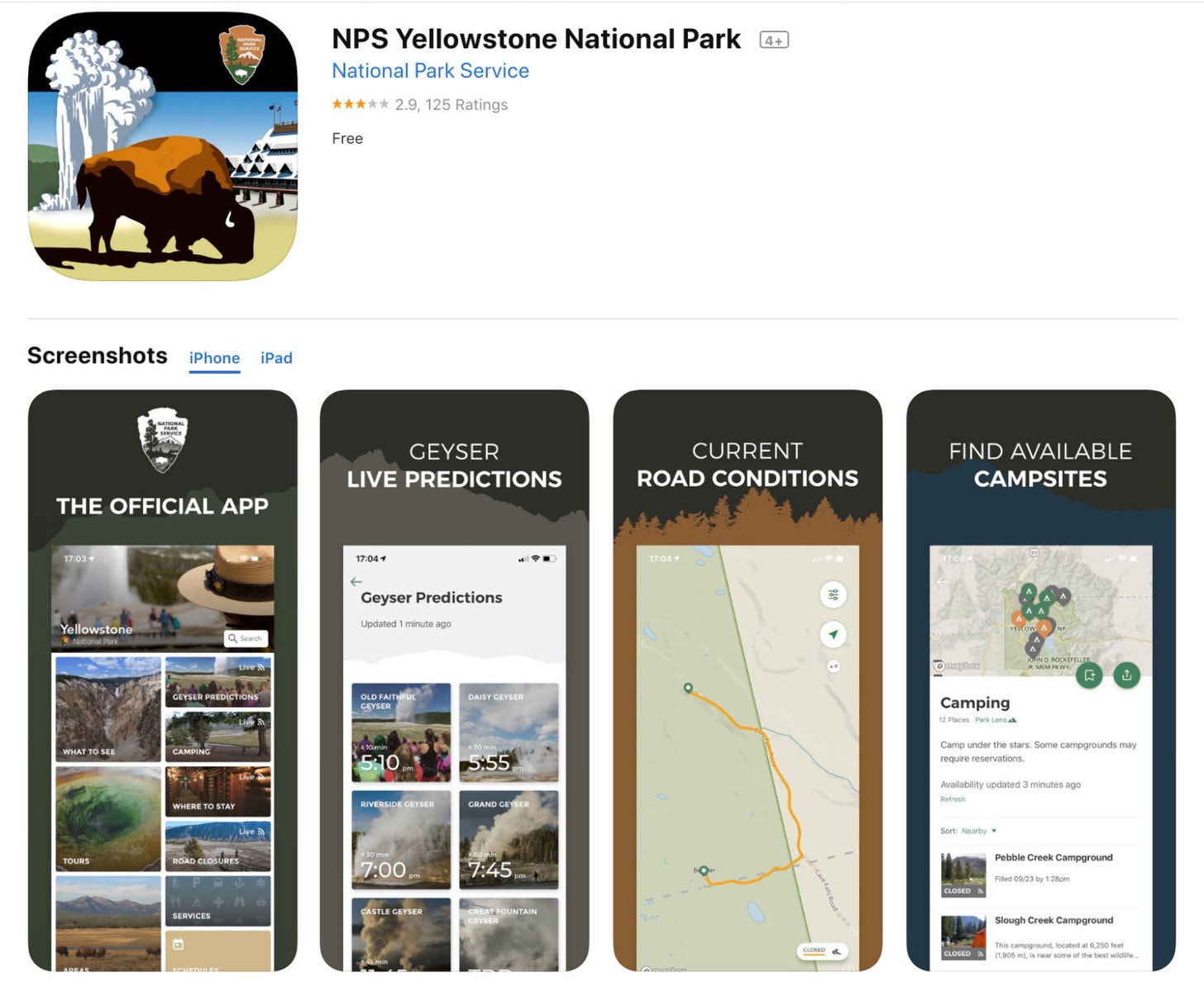
While their app is informative, we found the GyPSy Guide app on Yellowstone to be way more comprehensive and helpful. Which, again, is why we recommend it. And as a reminder, it works offline and without cell service too.
23. Beware of Federal Regulations in Yellowstone
Did you know if you receive a ticket in Yellow National Park, it's a federal offense? If you get a ticket for speeding or littering or a DUI, you’re going to have to answer to a United States federal court.
Needless to say, we think you should follow the law no matter where you are but especially here.
- Drive the speed limit: unless otherwise posted the maximum speed limit in Yellowstone National Park is 45 mph
- Don't litter
- Don't drive drunk
- Obey the rules by not approaching or touching animals and staying on designated trails and paths where applicable
24. Hunting is Illegal in Yellowstone National Park
So please don't try to do it! Ironically, it's legal to bring a gun into the park but illegal to fire it for self-defense, hunting, or otherwise.
25. Fishing is Legal with a Permit
Fishing, however, is legal in Yellowstone National Park with a permit. Don't try to fish without one! The General Stores in the villages and Visitors Centers are just two of a few places you can buy them.
You can obtain a permit from within the park and you don't need a state permit to do so. Simply acquiring a fishing permit for Yellowstone is enough. Three-day, seven-day, and season-long permits are available.
The season starts on the Saturday of Memorial Day and lasts until the first Sunday of November. Besides, who wants to ice fish in December and January anyway? (Only half kidding!)
➜ Grab the National Park Planning Bundle to Make Your Trip as Smooth as Possible!
26. Most Visitors Never Venture Off the Roads Throughout Yellowstone
It was a little surprising to learn an incredibly low percentage of visitors to Yellowstone get off the roads into the trails from our guide, Sam, on our Austin Adventures trip. Yet, upon reflection and thinking of my own comfort level with hiking solo or even in a small group in the wilderness, it made sense.
If you're not so comfortable with hikes on your own why would you venture out without real knowledge of how to deal with things like bears in the wild? Or knowledge of how much your body can handle on a hike?
This is another good reason it's great to go on an organized tour with experienced guides as we did with Sam of Austin Adventures. They have a greater comfort level with trails and knowledge of first aid in case of emergency. And, of course, with bears and how to deal with them should an encounter occur.
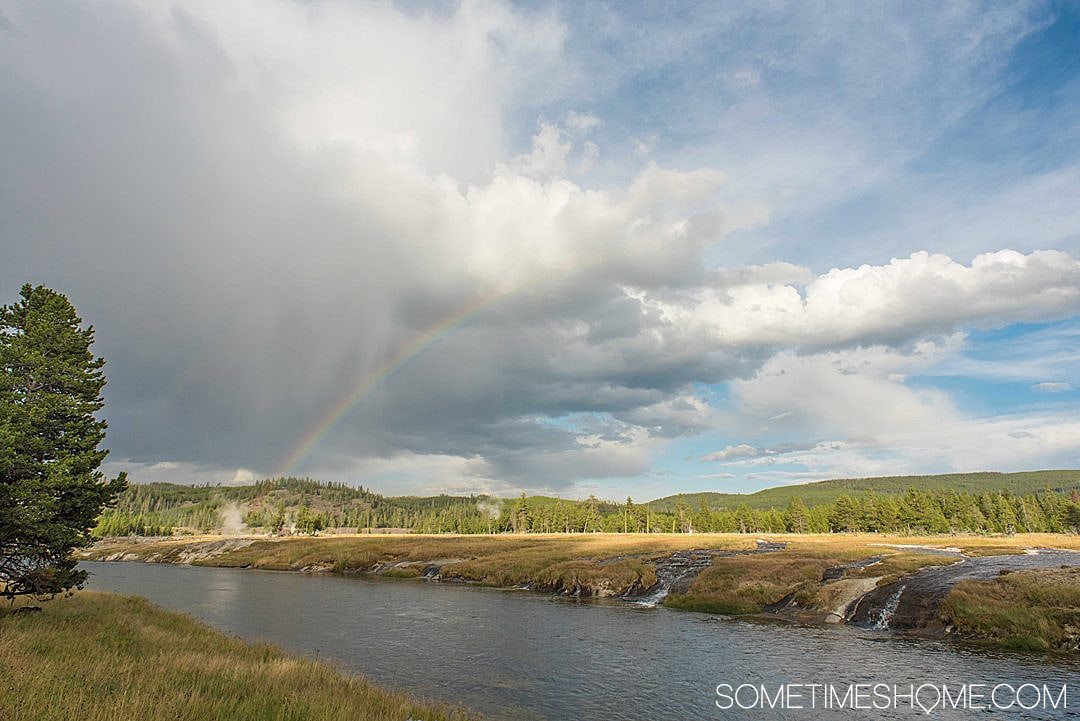
At the VERY least, buy this incredibly affordable National Park planner from a National Parks expert, so you can organize your thoughts (and hikes) before you venture out without a guide.
One of my favorite walks (a small hike, if you can call it that) was to the overlook for Grand Prismatic Geyser. It was a simple trail and not too difficult to find yet there was a noticeable difference in the number of people walking that trail versus the number we saw at the lower level boardwalk.
There's a boardwalk that walks in front of the trail where the fog coming off the geyser was so thick you couldn't even see its brilliant colors. Yet Sam knew to take us to a dirt trail that overlooked it. It was so worth it! We also saw a rainbow on the walk back to the parking lot!
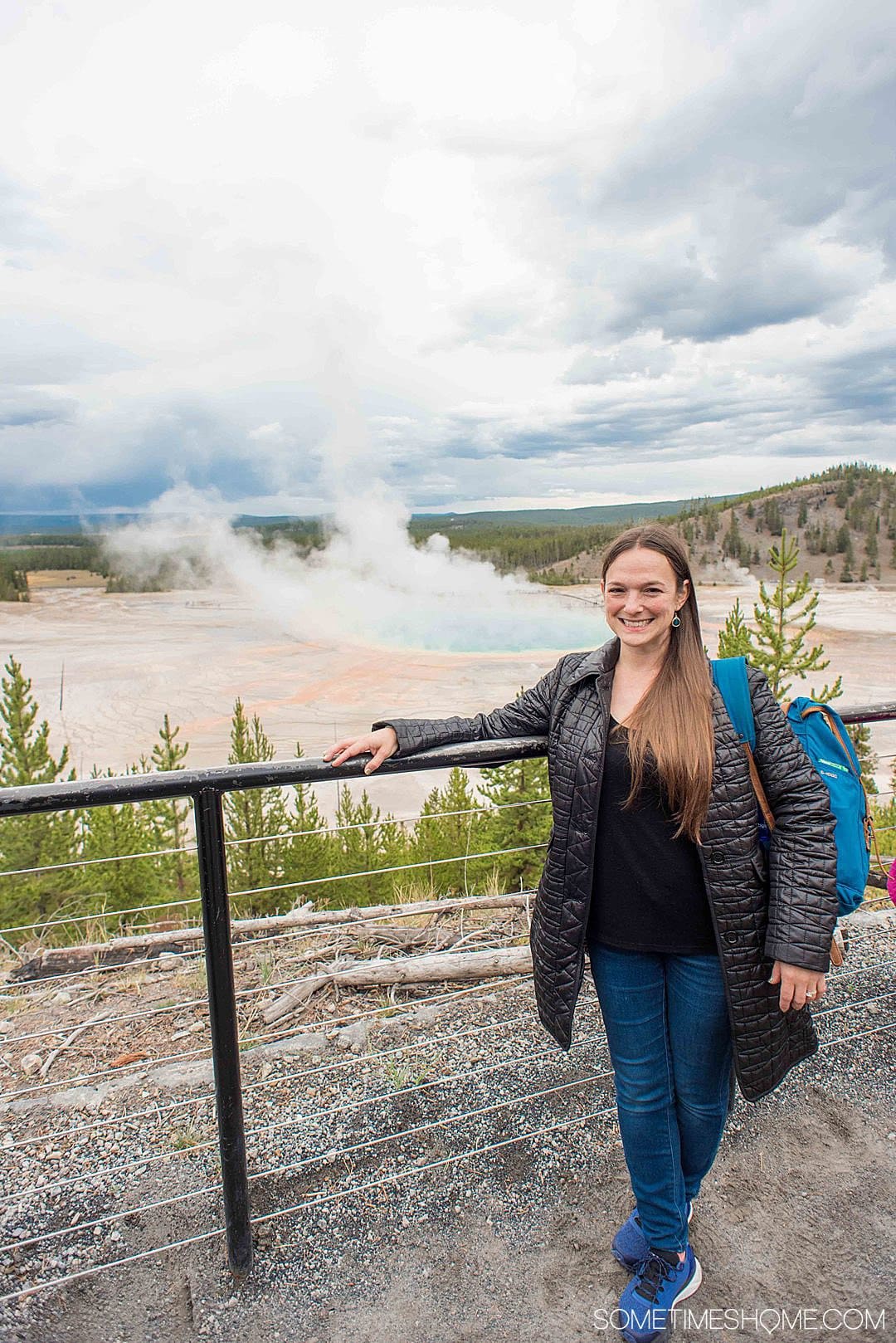
27. You Can Rent Bear Spray at the Park
Bear spray is very expensive and the cans of it are single-use only. It’s pretty much an incredibly powerful can of the solution, like mace, that will temporarily disable the bear’s site, thus making it possible for a human to escape a dire situation.
Due to its expensive, and the unlikelihood you’ll need it, it’s available for rent in the park. This enables the renter of the spray to feel secure on hikes should they encounter a bear, without the commitment of paying for the entire can.
The renting station keeps a portion of the money you pay to rent it but if you return the can, unused, you get most of the rental fee back. Should you need to spray and used it, they keep the full amount paid. It’s like bear spray insurance. 🙂 And assurance!
If you're going to rent bear spray, there's a brief, helpful video on the NPS website worth watching for tips on how to use it.
28. There's Traffic in Yellowstone National Park
Some roads in the park will be clear and you'll have smooth sailing. But other roads may be at a standstill or moving at 10 mph. During peak times, such as in June, you can sit in a traffic jam for longer than you'd like. Or it's common to have to wait to get into a parking lot due to heavy traffic.
When we visited in mid-September, we got out of the van and walked over to Grand Prismatic geyser while our Austin Adventures guide, Sam, waited in a line of cars creeping into the lot. It was simply faster for us to walk five to ten minutes than the fifteen to twenty he needed to deal with traffic.
Another common reason for traffic being at a standstill is wildlife on the road. It's common for American Buffalo, especially, to be crossing and often bears too. Again, I can't emphasize enough it's important to respect the wild animal. Do not approach or touch them. And definitely don't provoke them!
29. One Type of Tree Covers Most of the Park
Lodgepole pines account for over 95% of the trees growing in Yellowstone National Park. Needless to say, they thrive there! The height of a full-grown Lodgepole Pine, also known as a Black Pine, is 70 to 80 feet and they live to be about 200 yrs old.
They are conifer evergreens, which pretty much means they're cone-bearing trees that keep their needles year-round.
There are many different plants in Yellowstone, but it's worth noting this pine in particular as you'll see it nearly everywhere. Sometimes you'll see some bark missing from the base of the trunk. This is due to the bison (or American Buffalo) using it to help shed their thick winter coats when the seasons change.
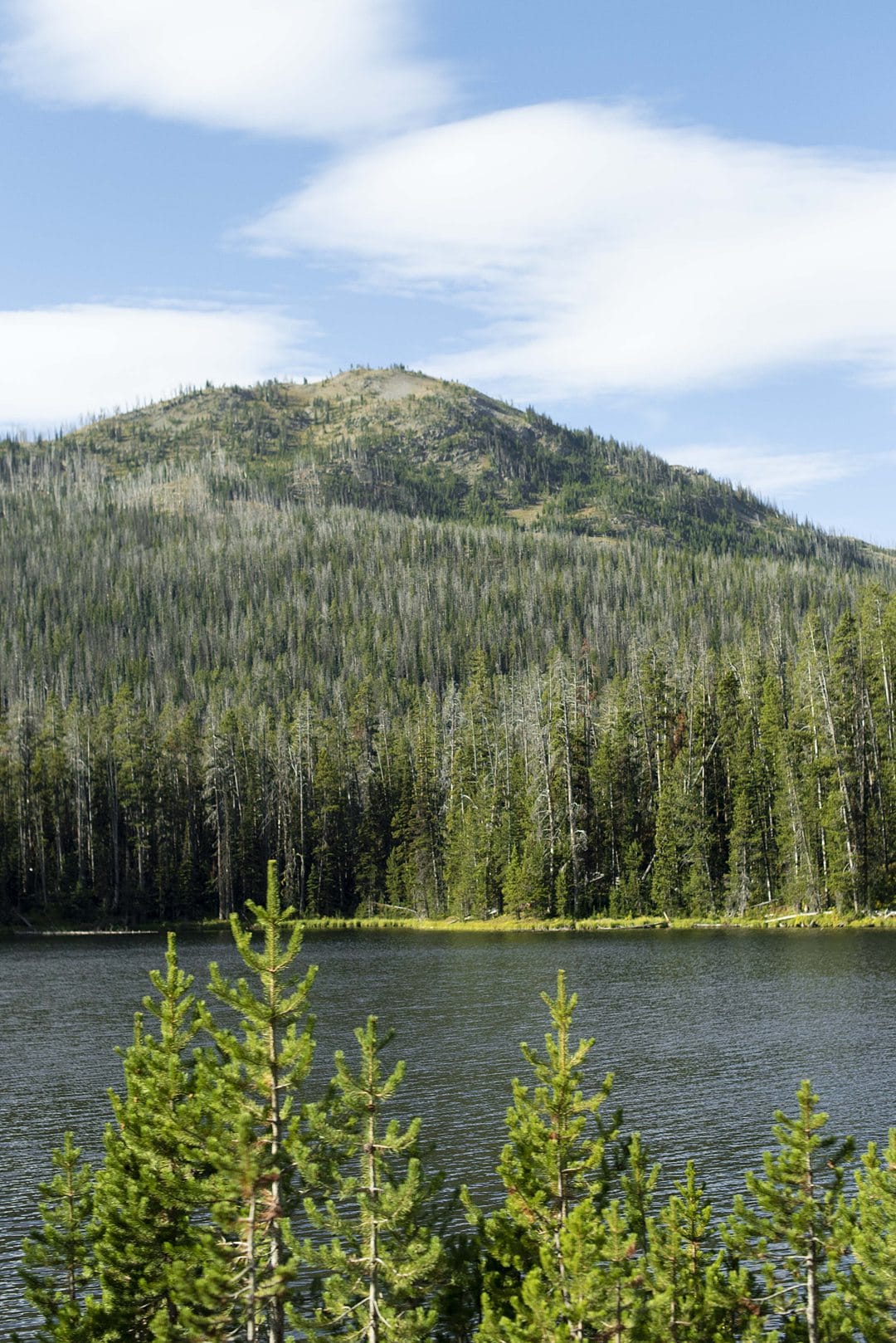
30. You Can Increase Your Odds of Spotting Wildlife
One of the most entertaining things to do in Yellowstone National Park is to try to spot wildlife. Here are tips to increase your odds of seeing animals throughout the park:
- Ask Park Rangers if there is wildlife to be seen somewhere at one of the village visitor centers
- If there’s a group of people gathered by side of the road, stop. Ask what they are stopped for (it’s likely because they see an animal!)
- Follow commercial tour vans. They often know the places to go for increased chances of spotting wildlife
- Look for discolored shrubs that move: because they’re not discolored shrubs. They’re probably an animal. This is likely the scene if you’re looking far off in the distance though of course, it’s possible in the closer foreground of your view as well.
- Get binoculars or a scope (by purchasing or renting one) to help make your eyesight extra superhuman.
- Have patience and extra layers of clothes because you may need to sit outside for several hours to succeed.
- Be methodical about your visual search. Go from tree lines at the top of the mountain down to roadside trees ….and repeat to the side of where you started. Being sensical about your search will enable you to thoughtfully scan the area’s landscape increasing your chances of wildlife-spotting success.
- Remember spotting wildlife is often a crapshoot. You can get lucky and randomly see bears or you can have patience and do everything right and see nothing. But I’ll keep my fingers crossed for you if you do the same!
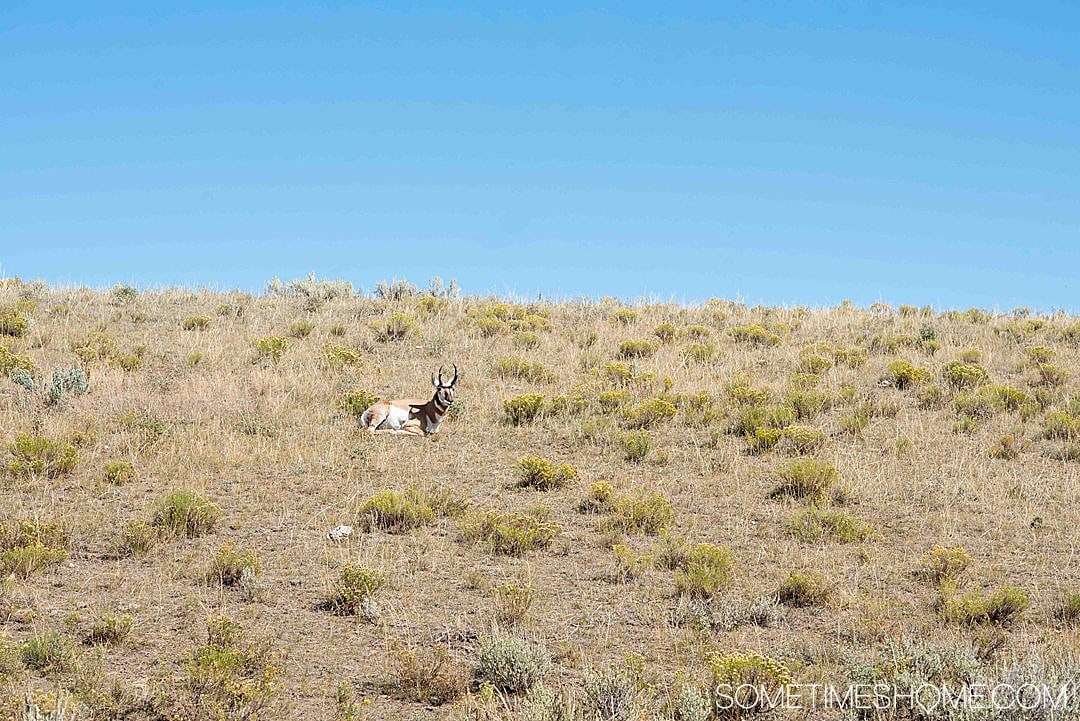
Here are a few of the animals we saw on our two days in Yellowstone National Park with Austin Adventures:
- A moose (from very far away)
- Ravens
- A Red Tail Hawk
- Swans and ducks
- Black bears
- Pronghorns
- Wolves
- Elk
- Chipmunks
- Mountain Goats
- And of course, Bison or American Buffalo. There are between 4,800-5,200 in the park. Females are 1,500 pounds and males weigh about 2,000 pounds. They can survive in temperatures of -40 in winter and they shed their two to four-inch-thick coats for summer.
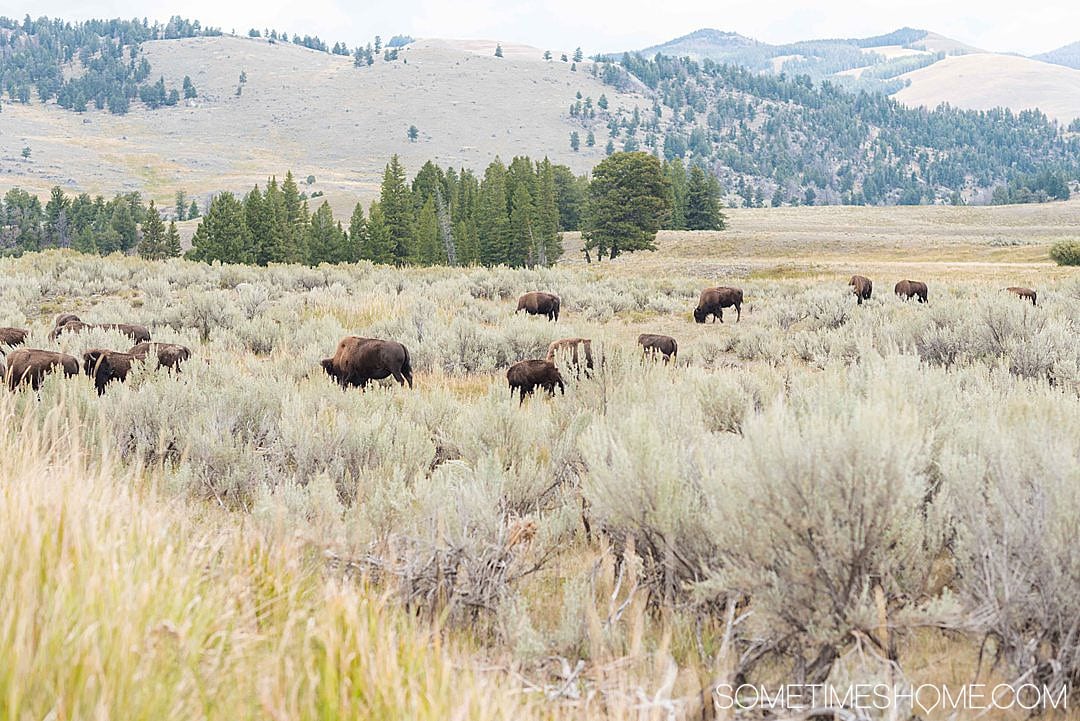
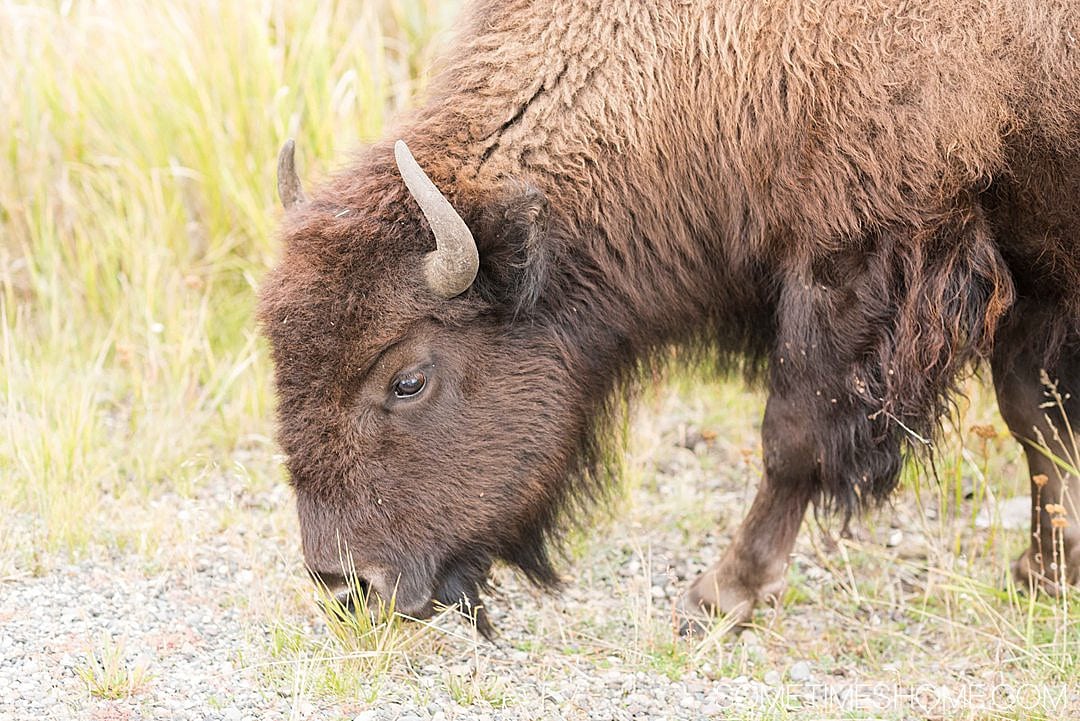
Bonus info: How Old Faithful Got Its Name
And lastly, for a fast fun fact in Yellowstone National Park, we ask, “Why is Old Faithful geyser named as such?”
It’s because it faithfully erupts every 90 minutes, within 10 minutes of a predicted eruption time! They even indicate the next time it will erupt at the surrounding Old Faithful accommodations around the geyser, such as on the wooden sign pictured below.
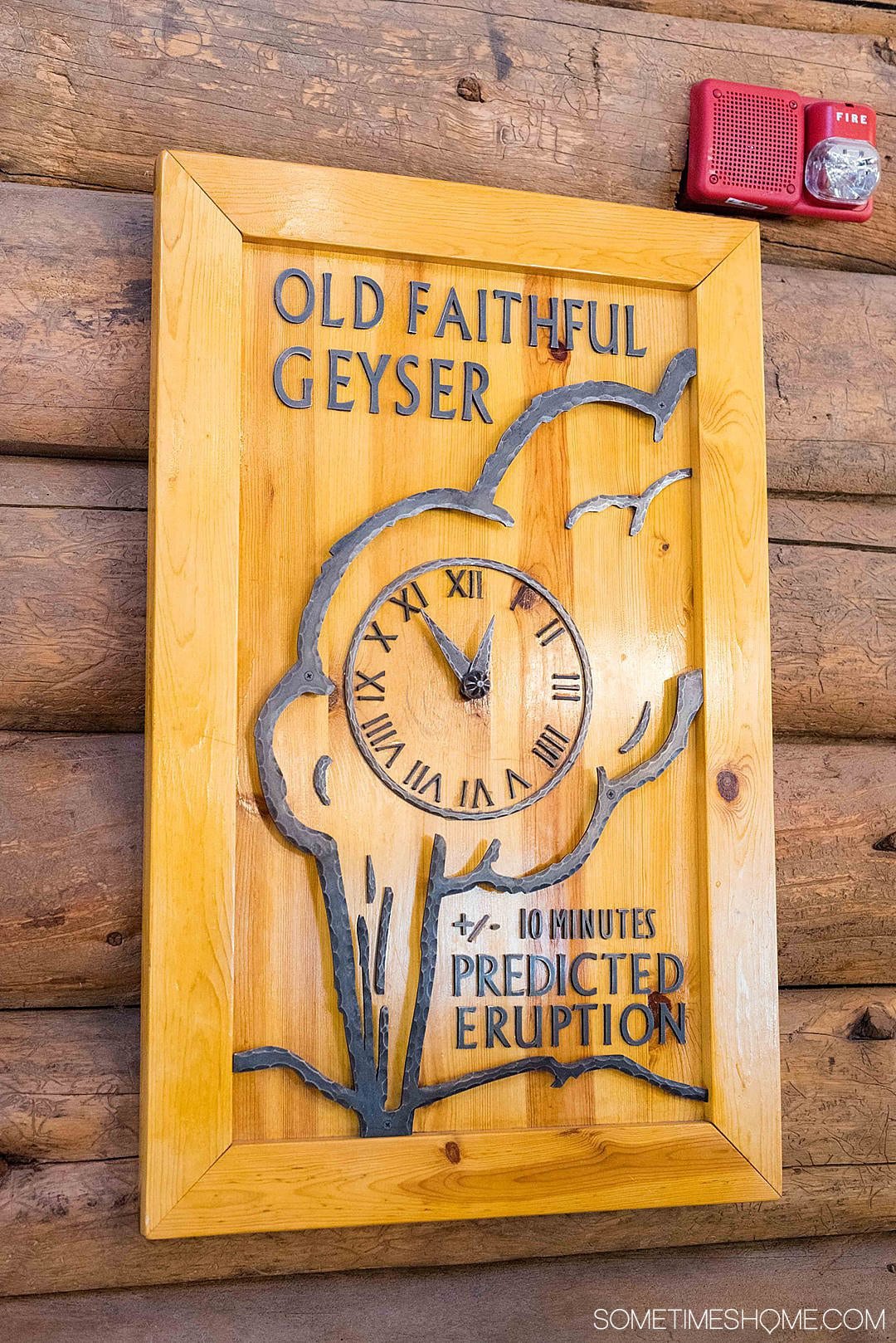
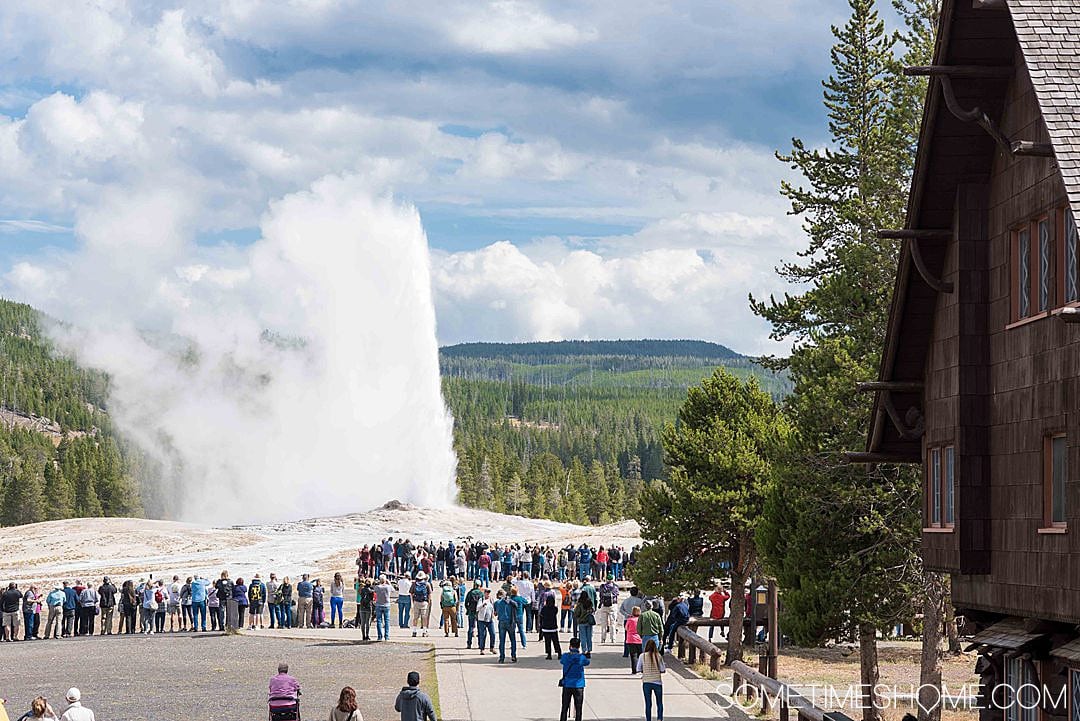
Do you love nature? Here are a few posts to inspire your outdoor travel:
- Hiking Near Morganton NC: Refresh Outdoors in Burke County
- 5 Tromso Excursions You’ll Love
- Amsterdam to Keukenhof: The Tulip Gardens of Your Dreams






